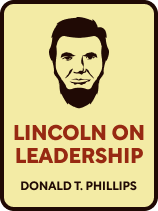

This article is an excerpt from the Shortform book guide to "Lincoln on Leadership" by Donald T. Phillips. Shortform has the world's best summaries and analyses of books you should be reading.
Like this article? Sign up for a free trial here.
What is Donald T. Phillips’s Lincoln on Leadership about? What are some of the key takeaways you can draw from the book?
In his book Lincoln on Leadership, Phillips uses historical events, documents, and speeches to explain Lincoln’s leadership style. He also outlines how you can adopt Lincoln’s methods for yourself and your organization.
Below is a brief overview of Donald T. Phillips’s Lincoln on Leadership.
Lincoln on Leadership: Executive Strategies for Tough Times
Many consider Abraham Lincoln the greatest US president of all time. He held the presidency from 1861 to 1865, and during that time, guided the Union to victory in the American Civil War and signed the Emancipation Proclamation—a document that began the process of ending American slavery.
While many Lincoln scholars focus on what he did, author Donald T. Phillips explores how he did it. In this guide, we’ll examine the three aspects of Lincoln’s leadership that Phillips argues were crucial for his success:
- In Part 1: Working With Others, we’ll explain how Lincoln communicated and collaborated with the people around him.
- In Part 2: Leading Ethically, we’ll explain how Lincoln’s personal character and values informed (and improved) his decision-making.
- In Part 3: Making Decisions, we’ll explain Lincoln’s process for deciding what actions to take.
(Shortform note: Phillips’s book Lincoln on Leadership is part of a specific genre that draws lessons on contemporary leadership from the biographies or histories of important past leaders. Examples of this genre include How to Be a Leader: An Ancient Guide to Wise Leadership (a compilation of essays from first century CE historian Plutarch), Doris Kearns Goodwin’s Leadership: In Turbulent Times, and Brent Taylor and Mindi Bach’s Presidential Leadership. All of these works examine the lives and decisions of past leaders to learn how they succeeded or failed—and then try to present these lessons in a way that’s accessible and applicable to any type of organization.)
Part 1: Working With Others
Phillips begins by discussing how Lincoln worked and interacted with the people around him and how his style of communication benefited him. In Part 1 of the guide, we’ll explore the two main lessons Phillips says you can learn from Lincoln, as well as how Lincoln himself used these methods in his life and career. These two lessons are:
- Make yourself accessible and create an environment where your employees are comfortable talking to you freely and openly.
- Build strong relationships with your close colleagues so you can communicate and work together effectively.
Lesson #1: Make Yourself Accessible
Phillips argues that leaders should be open, accessible, and friendly to the people around them. This includes being around if people want to talk to you, as well as having a friendly and welcoming demeanor. By making yourself easy to approach and listening to your employees, you’ll gain their trust and respect—they’ll see that you care about their opinions and are committed to working alongside them. In addition, by talking to people on every level of your organization, you can gain valuable information about how things work and how you could improve them. This information can then help you make well-informed decisions later on.
Phillips writes that Lincoln practiced these principles throughout his presidency, going out of his way to be accessible. Lincoln accomplished this by spending a lot of his time talking with others—from high-ranking generals and politicians to common soldiers and farmers. He’d frequently visit people where they lived or worked and had an “open-door” policy where people could come talk to him at any time. In addition to meeting lots of people, Lincoln also made himself accessible through his demeanor and rhetoric: He was friendly, had a good sense of humor, rarely gave harsh commands or orders, and used clear and simple language to connect with whoever he talked to.
(Shortform note: Though Phillips and other scholars praise Lincoln’s accessibility and “man of the people” attitude, the president’s public availability wasn’t without its risks. Confederate spies (who either worked directly for the Confederacy or were just sympathizers) were commonplace in Washington, D.C.’s political and social scenes. By making himself available to the public (despite the protests of those close to him like Union spy Lafayette C. Baker, who was concerned about Lincoln’s safety), Lincoln often put himself in danger—danger that turned out to be very real when he was assassinated in 1865.)
Lesson #2: Build Strong Relationships
In addition to traveling and meeting lots of different people, Phillips suggests that you put extra effort into building strong relationships with the people working directly underneath you. By getting to know them personally as well as professionally, you can eliminate misunderstandings and find common ground with your subordinates—even those who might initially dislike you or disagree with your views. Once you’ve built these relationships, those directly under you will also learn to understand you and what you want. This means they’ll do better work and won’t need as much (if any) oversight from you.
(Shortform note: While Phillips focuses on getting close to your existing employees, Jim Collins (Built to Last) claims that the process of building close ties with your employees starts before they’re hired. Collins explains that during your hiring process, you should look for people who agree with the core philosophy of your organization—how you see the world and what you’re trying to accomplish. By screening for similarly-minded people, you’ll hire employees who are more invested in you and your organization because they believe in it. For example, Collins notes how the Walt Disney Company uses its hiring and onboarding processes to teach its company philosophy and ensure that employees believe in that philosophy.)
Similarly, Lincoln would often personally get to know his closest advisers, generals, and political allies. He’d visit their homes and meet their families to try to get a sense of who they were. This helped Lincoln understand the viewpoints of his allies and how he could best use them. Lincoln was even able to build relationships with some of his former political rivals or those who disagreed with many of his policies.
Part 2: Leading Ethically
While techniques and methods are an important part of learning to lead, Phillips argues that excellent leadership requires more than just a skillset. It also requires moral and ethical decision-making—a framework that enables you to define the principles your organization stands for and how it runs in accordance with those principles. Lincoln understood the importance of leading ethically, says Phillips, and he consistently held himself to a high moral standard.
(Shortform note: James Barber (The Presidential Character) goes further than Phillips, arguing that character and values are the main qualities that determine presidential success (even more than technical knowledge or skill). Barber specifically argues that successful presidents have “positive and active” characters—in other words, they value determination and enthusiasm. From Phillips’s perspective, such a president would succeed by instilling those same values in their organization as a whole to create a productive and persistent government.)
In particular, Phillips draws two major lessons on leadership from Lincoln’s ethical conduct:
- Stick to your values, and make sure that every decision you make aligns with them.
- Keep your ego in check, and don’t let personal pride or emotion control you.
Lesson #1: Stick to Your Values
Phillips argues that standing by your moral values is necessary for being a leader. Your values will come to define the values of your organization as a whole, claims Phillips—if you lie and cheat, then your employees will feel comfortable doing the same. If you’re honest and fair, your employees will want to follow your example. An honest and ethical organization is a better organization, says Phillips—it improves morale, makes your employees want to work harder, and helps them communicate openly.
(Shortform note: To recognize the current values of your company, John C. Maxwell (21 Irrefutable Laws of Leadership) explains that you should pay attention to the information that people share with you. If people feel comfortable sharing bad news or criticism with you, that means you’re cultivating personal and company values that support trust, honesty, and openness. However, if you rarely or never hear critiques and bad news, then chances are your employees aren’t comfortable being truthful—Maxwell suggests that this often means they see you as untrustworthy. If you recognize that your company values dishonesty, then you should first examine your own conduct and see how you can act more honestly.)
A major part of Lincoln’s legacy, writes Phillips, is his moral code, particularly when it comes to telling the truth. In both his personal and professional lives, “Honest Abe” (as he was known) didn’t make exceptions to what he thought was right. He also tried to encourage similarly honest values among his employees. Sometimes this meant gentle guidance or persuasion, and sometimes it meant demoting or firing people who didn’t share his values. Because of this, Lincoln didn’t just passively preach his values—he actively fought for them.
(Shortform note: Some historians argue that “Honest Abe’s” moral conduct was more of a myth than a historical reality. They suggest that the image of Lincoln as a kindly, just, and truthful politician was in part created by the people around him (especially after his death). These historians explain that while Lincoln was in many cases an ethical man and politician, people shouldn’t take that to mean he never lied or never went against his moral beliefs. These things did happen—for instance, early in his political career, Lincoln once wrote anonymous letters making vicious personal attacks against a political rival.)
Lesson #2: Keep Your Emotions in Check
While values should be a major part of your decision-making, Phillips argues that your ego should not. In particular, he says that you should never lose control of your emotions or become petty and spiteful. If you act on these emotions, you’re more concerned with your self-image or gratification than with what’s best for your organization—a clear example of unethical leadership. In addition, acting on ego or negative emotions discourages your employees from being open and honest with you—for instance, if you blow up at criticism, they’ll be less likely to offer differing viewpoints. However, if you’re understanding and don’t take things personally, your employees will feel more comfortable being open with you.
(Shortform note: Some management and leadership experts argue that emotions should be a major part of your decision-making process. They argue that while negative emotions like pettiness or personal pride won’t help you make good decisions, you still have to acknowledge when these (and other) emotions arise in your organization. Experts suggest that the ability to read and understand emotion is a crucial part of communication—and is, therefore, a crucial part of being a leader.)
Likewise, during his political career, Lincoln was able to keep his ego in check despite a constant deluge of (frequently unfair) criticism from his political rivals and the press. Often this simply meant ignoring the criticism, though he’d occasionally respond to serious attacks questioning his values or moral standing. Instead of letting his emotions control him, Lincoln was compassionate and considerate of the viewpoints of others—he famously pardoned many deserting Union soldiers and even ex-Confederates during the Civil War. When Lincoln felt strong emotions, he’d look for private ways to let them out, like writing angry letters he never sent or speaking to a close confidant.
Part 3: Making Decisions
Now that we’ve discussed Lincoln’s communication and character, we’ll look at how he actually made the crucial decisions that defined his presidency. Part 3 of our guide will explain Phillips’s breakdown of Lincoln’s decision-making process, why it works, and how you can use it. We’ll explore the two main lessons that Phillips draws from Lincoln’s decision-making process:
- Consult together, decide alone by asking your employees for input and ideas, then making all final decisions on your own.
- Plan and persevere by setting long-term goals and consistently sticking to them.
Lesson #1: Consult Together, Decide Alone
While you should consult with your employees on possible courses of action, Phillips argues that all final decisions you make must be yours and yours alone. This strategy gives you the best of both worlds:
- By consulting with your employees, you get access to different ideas and viewpoints. If you use one of their ideas and it works, Phillips suggests you give them credit—this encourages your employees to continue doing good work.
- By making the final decision alone, you ensure that your course of action fits your overall vision of how your organization should run. In addition, if the decision doesn’t work as planned, Phillips explains that you can shoulder the blame. By not blaming your employees for ideas that don’t work out, you’ll maintain their respect and won’t discourage them from offering new ideas or suggestions.
(Shortform note: Once you start consulting together and deciding alone, Stephen R. Covey (Crucial Conversations) explains that you have to make this process clear to your employees. This means clearly separating when you’re consulting and when you’re deciding. Separation helps you avoid misunderstandings or confusion about who has the final say and what your decisions are. For example, in a group discussion or consultation, people can often agree on a general idea but not on the specific steps necessary to achieve it. But by clearly separating consulting from decision making, your employees will know when you’ve chosen a specific course of action rather than when you’re simply introducing another idea.)
Phillips outlines how Lincoln would often “consult together and decide alone” to help encourage and guide his employees. By offering praise or accepting blame, he subtly pushed those under him to do what he wanted—if he wanted a general to be more aggressive, for example, then he’d praise their aggressive actions or accept blame for an aggressive decision that failed. By using this strategy, Lincoln still had control over what his employees were doing, but he also made them feel like their victories were their own—encouraging them to continue doing good work.
(Shortform note: Historians note that Lincoln’s decisiveness came to define the role of the presidency during times of war and crisis. Though for Lincoln this often meant consulting with advisors and other politicians, it also often meant overriding their will—and overriding portions of the Constitution itself. These historians note that Lincoln invented the idea that the president could suspend certain rights during wartime—most notably habeas corpus, which requires that people detained for a crime be brought before a court where they can be lawfully charged. The legacy of these decisions is mixed: While scholars like Phillips argue that these decisions represented necessary decisiveness in the face of a major threat, others argue that they created dangerous precedents that later presidents would abuse.)
Lesson #2: Plan and Persevere
Making your own final decisions helps you plan and persevere—something that Phillips says every leader should do. He argues that you should create a long-term plan for your organization and then consistently stick to it. This doesn’t mean you should refuse to change your course or micromanage every single detail, but instead that you should set goals and have a general idea of how you’re going to reach them. By creating a plan and sticking with it (despite any obstacles), you’ll be able to set and maintain clear expectations for your employees regarding what they should do and how they should do it. This will help them do the kind of work you want them to do.
(Shortform note: For more advice on how you can create a long-term plan, the authors of Extreme Ownership outline several factors important for planning: resources you have available, risks you might encounter, contingency plans for those risks, and how to explain your plan in a simple and concise way. When you keep these factors in mind, you’ll create a realistic plan that’s flexible and easy to understand—all of which are important for overcoming obstacles and succeeding.)
Similarly, from the moment he came into office, Lincoln had a plan, explains Phillips. Lincoln wanted to reunite the country and abolish slavery, and every action or decision he made tried to serve that end in some way. In addition, Lincoln ensured that these goals were clear to those underneath him—and ended up replacing many generals and cabinet members who either couldn’t or wouldn’t work toward them. Phillips argues that consistently pushing toward these goals helped improve Lincoln’s decision-making, as it prevented him from stalling his own efforts or accepting short-term gains that would harm him in the long run.

———End of Preview———
Like what you just read? Read the rest of the world's best book summary and analysis of Donald T. Phillips's "Lincoln on Leadership" at Shortform.
Here's what you'll find in our full Lincoln on Leadership summary:
- A look at what Abraham Lincoln did and how he did it
- Leadership lessons you can learn from Lincoln
- Why you should consult together and decide alone






